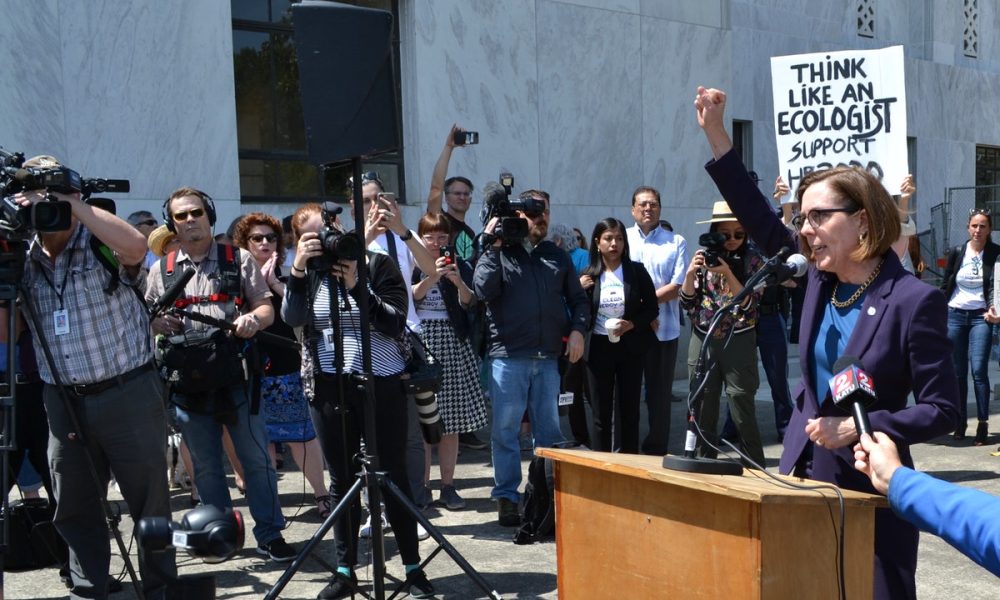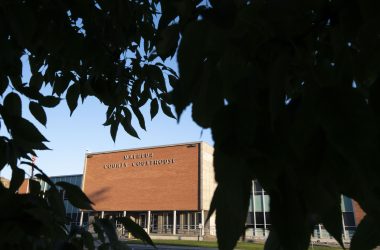 Gov. Kate Brown speaks at a rally promoting carbon capping legislation.
Gov. Kate Brown speaks at a rally promoting carbon capping legislation.
For more than a year, Gov. Kate Brown’s environmental agency has been assessing how the governor could mandate lower greenhouse gas emissions without voter or legislative approval, according to interviews and public records.
Brown has said she’s willing to act with her executive authority if lawmakers and industry don’t reach agreement on ways to limit greenhouse gas emissions over the next several decades.
Her spokeswoman, Kate Kondayen, reiterated that point, saying that Brown would rather see legislative action.
“The governor has been meeting with stakeholders from the agricultural sector, transportation sector, and wood products industries throughout the summer and will continue to do so into the fall to ensure that the policy benefits rural Oregon while allowing rural Oregon industries to remain competitive,” Kondayen said in a statement. “In the meantime, she has instructed her team and agencies to explore all options to achieve Oregon’s emissions reduction goals.”
Kondayen didn’t otherwise respond to written questions.
Richard Whitman, director of the state Department of Environmental Quality, said his agency started talking with the governor’s staff a little more than a year ago, exploring what options were available. Those efforts were sidelined as momentum picked up ahead of the 2019 Legislature for a comprehensive carbon capping program. The costly and controversial legislation setting the program in place famously failed in the final week of the session.
DEQ, responding a public records request, released 39 emails dating from October 2017 to last June documenting communication between Brown’s office and DEQ regarding curbing emissions outside of legislative action. Much of the correspondence regarded suing the federal Environmental Protection Agency to ensure Oregon maintains the authority to use executive powers to regulate polluters.
An outline of the potential executive actions available to the governor was sent by Whitman to Brown’s advisors and a state Justice Department five days before the legislative session ended without a carbon emissions policy passing.
Brown had no desire to let the work and momentum behind a carbon-capping program fizzle. Less than 24 hours after the session closed, she called reporters into her office and threatened to use her executive powers to lower carbon emissions.
Immediately, DEQ resumed its work vetting those options.
Whitman said his office is in weekly, if not daily, communication with Brown’s staff on the effort.
“We are on a pretty steady pace working on these issues at this point,” he said.
The June 25 internal document outlines a gradually declining cap on industrial emissions and fossil fuel importers, strengthening Oregon’s low carbon fuel standard and increasing access to public transit and promoting biking and walking.
DEQ also outlined ways to strengthen regulations on landfills to lower methane emissions, more strictly regulating dairies, expanding vehicle inspection programs so that medium-duty trucks are inspected twice per year and requiring newly built buildings include electric vehicle charging stations.
Whitman said the main focus of the agency’s proposal is on capping industrial emissions. And while executive action can be extremely powerful, it lacks the nuance afforded by the legislative process, he said.
Going the legislative route allows the state to be less restrictive of industry, giving it the best “bang for its buck,” Whitman said.
In 2019, lawmakers developed a policy were a cap on carbon came alongside “allowances” equal to one ton of pollution. Those allowances would have been purchased from the state at auction and then became a commodity for the holders, as they could be resold or traded.
Lawmakers also designed a system to give free allowances to companies that would struggle to compete on a national or global scale under the new regulations. The policy would have also allowed companies to invest in “offsets” like preserving timber stands rather than buying allowances.
With executive action, Brown is not afforded that level of creativity. More or less, she is allowed to limit emissions, but is more handcuffed in helping industry make the transition.
Brown has not said how extreme the new emission regulations could be, but any change would likely impact business, and in turn could impact consumers and the overall economy.
Whitman said executive orders might not result in the overall emissions reduction being done in the most efficient way.
Brown’s potential executive action is likely to draw political fire.
“I am severely disappointed with the governor wanting to move forward with executive action, when the Legislature clearly did not get the cap and trade program right,” said Rep. David Brock Smith, R-Port Orford. Brock Smith served as co-vice chair of the joint committee that studied the issue and produced the cap-and-trade legislation – House Bill 2020.
Brown has been quiet on the issue since holding her press conference in June.
“The really major issue here is that if Oregon DEQ were to proceed with a program, particularly around capping industrial emissions or fuels … it likely would be kind of a blunt instrument, frankly,” Whitman said.
Brad Reed, spokesman for environmental coalition Renew Oregon, said action is needed now. Renew was one of the chief proponents for the policy but Reed said executive action could be a start.
“The governor should do everything she can to combat the climate crisis,” Reed said.
Reed said after her announcement, Brown met with Renew’s policy analysts to go over the most effective ways to use agency authority to cut down on emissions.
Reducing pollution was only one part of the legislative plan, though. The cap-and-trade program would have generated millions for climate projects around the state.
That also becomes more difficult with executive action. DEQ could raise money through increased fees for things like industrial or agricultural permits, but that would require legislative approval.
“I think it’s highly unlikely that we would be able to operate a program that generates revenue for things that reduce greenhouse gas emissions,” Whitman said.
And while DEQ analysts have narrowed what options to consider, they continue to examine how best to implement new rules and regulations.
Whitman said he’s working under the directive from Brown to design the most workable program, and then let Brown and her team decide what to do with it. However, if the governor side steps lawmakers and imposes new regulations, she would likely face anger from some legislators.
In two years, Whitman and DEQ would have to go through the ritual of getting legislative approval for a new budget. Brock Smith noted that he sits on a committee that considers DEQ’s budget.
“DEQ did not get everything they wanted in their budget to fund existing programs at the levels they desired,” Brock Smith said of the current budget. “By adding programs that would implement portions of a cap-and-trade program that would be punitive to industry, especially in rural Oregon, it would be more difficult in my opinion to fund programs that are already underfunded, but also those that would be punitive to industry.”
Whitman said any potential retribution is far from his mind.
“In terms of the politics of how it’s designed … I’m not going to lose a whole lot of sleep over that,” Whitman said.
Aubrey Wieber is a reporter for the Oregon Capitol Bureau, a collaboration of Pamplin Media Group, EO Media Group and Salem Reporter.




